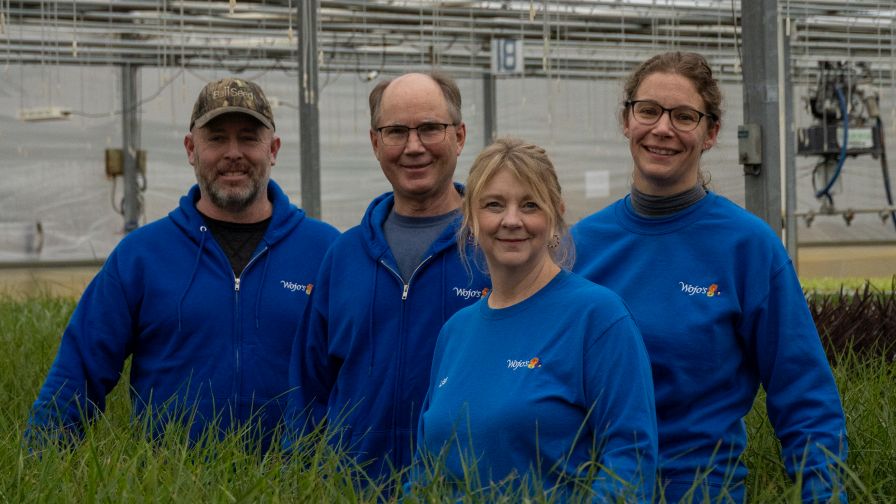
The management team at Wojo’s Greenhouse (L to R: Zach Campbell, Joe Wojciechowski, Lisa Kemeny, and Traci Barber) are excited about how the company’s new ESOP program will move the company into the future. | Wojo’s Greenhouse
The last couple of years have borne witness to many family-run floriculture businesses being challenged with what to do when the owner begins making plans to retire, even though there’s no one in the family to take over the business.
Wojo’s Greenhouse in Ortonville, MI, recently faced this dilemma. The operation, which began its journey in 1983 with a modest roadside stand, has grown into more than 275,000 square feet of greenhouse space, offering a diverse array of homegrown plants, including annuals, perennials, trees, and vegetables.
However, rather than close up shop, Wojo’s went in a different direction: it transitioned into an employee stock ownership plan (ESOP).
Going Through the Process
Joe Wojciechowski, owner of Wojo’s Greenhouse, says his goal has always been to keep the company moving forward when he’s ready to step into retirement.
“We have many customers that tell us they love to shop here, and we did not want to simply close the doors someday and let the place rust away,” Wojciechowski says. “Most of our employees have also said they would rather we keep the culture and community involvement that we have grown. They were concerned about what would happen if we sold the business to a third party.”
When Wojciechowski first started planning for the eventual transition of the company, he approached PivotPoint Business Solutions, a business management firm that specializes in exit planning, without even considering an ESOP as an option. Within a year, however, that would change.
“I knew about other companies, such as McHutchison [a horticulture distribution company], that had gone through the process of transitioning to an ESOP, so I decided to reach out to them,” Wojciechowski says.
Once he expressed interest in an ESOP, PivotPoint referred Wojciechowski to Prairie Capital Advisors, which worked closely with Wojo’s leadership team providing ESOP advisory expertise, and managing the preparatory, due diligence, and negotiation phases of the transaction, as well as structuring the financing for the transaction.
“Prairie’s website also provided referrals to other companies who had gone through the same process, including a local tree-trimming company I contacted to get their perspective,” Wojciechowski says.
Why Team Buy-In Is Critical
One of the biggest things Wojciechowski heard when talking to other companies was that when employees are told about the ESOP transition, most are hesitant at first, but over time they really come together as a team.
“When most of them think about it, they would rather keep the company culture than have a corporation come in and run it differently,” he says. “When we did roll it out to the employees, we had our Trustee come in and do a presentation.”

Wojo’s Greenhouse began as a modest roadside stand and has grown into more than 275,000 square feet of greenhouse space. | Wojo’s Greenhouse
He also heard from companies who have gone through the process that employees will often look at the company, and their roles, a bit differently when they know they are part of its future.
“When I talked to a tree-trimming company that recently did an ESOP, they noticed that, for example, employees started taking better care of equipment. They realized the value that their responsibilities and actions bring to the business.”
Lisa Kemeny, Vice President of Wojo’s Greenhouses, says the management team was involved from the beginning, and their feedback and buy-in were critical.
“Senior management was asked if we would prefer to sell to another organization or would we rather go to an ESOP,” Kemeny says. “Those opinions were definitely taken into consideration, and we’re excited and motivated to move the company forward with the standards and culture we have created.”
Kemeny also says the company recently created an employee growth and development plan to guide the team on how to advance in the company.
“We took the time to develop a document that has our values, and we use that as a guiding principle in decision-making,” she says. “Management has carried the values in our actions, and now they are written out for all employees to see how decisions are made.”
What They Learned
Because Wojo’s Greenhouse was going through uncharted territory, there was obviously a lot to learn during the process. There were also some reassurances.
“I’ve always tried to convey the importance of recordkeeping to our team, and this process showed why accurate recordkeeping is important,” Wojciechowski says. “The team at Prairie also noted a few times that our books were in really good shape and on track with where we needed to be. There are some areas where we need to improve, but if we can implement those changes, it will help make us a stronger company moving forward.”
Kemeny says she was able to learn a lot of business and financial information that can help her make better decisions for the company moving forward.
“That was probably the biggest learning curve for me. I feel like I took years of knowledge and learned it all very quickly,” she says.
Be Transparent
For other growers who might be uncertain about their future business succession strategy, Wojciechowski goes back to the importance of recordkeeping.
“You’ll learn quickly whether you’ve added more value to your business, but you’ll also learn just as quickly that you might not be running the business the right way,” he says.
Kemeny’s best advice for those considering an ESOP is to be as transparent as possible.
“Make sure your management team is committed to making it work and be open with all of your employees during the process,” she says. “Have frank conversations about the future direction of the company and know that there’s always room for improvement.”

